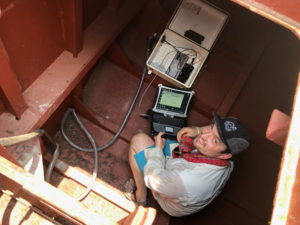
Rip in his element
In 2017, Rip Hale joined the staff at Old Dominion University (ODU) as an assistant professor in the Ocean, Earth, and Atmospheric Sciences department. His research looks at sediment transport and deposition across a variety of spatial and temporal scales using acoustic and optical sensors to measure the movement of water and sediment in coastal environments. These observations are then compared with data from sediment cores, where textural, radioisotopic, and geochemical signatures can fingerprint sediment sources and rates of sediment deposition and erosion. Ideally, he can connect a specific event (e.g., storm or flood) observed in the acoustic and optical sensors, with a corresponding deposit or erosive horizon observed in the sediment cores. By studying sediment dynamics in modern systems, he hopes to better understand the behavior of past systems, the remnants of which may now be buried beneath more recent sediment, or exposed in eroding cliff faces.
With the help of the talented graduate and undergraduate students working in his lab, he has ongoing research projects in southwest Bangladesh, the Lafayette River (Norfolk), and the eastern shore of Virginia. In Bangladesh, graduate student Kallie Brown is helping him to monitor how sediment transport and deposition are changing in the face of sea-level rise and human modifications to a natural system, in research sponsored by NSF, CRDF, and the PADI foundation. In the Lafayette River, graduate student Samantha McGill is investigating the causes of sediment resuspension, and a potential link between resuspension and the initiation of harmful algal blooms. REU student Ana Grace Alvarado is measuring microplastic abundances in the sediment and water column. On the eastern shore, REU student Jonathan Lucio is attempting to measure shallow water bathymetry using data collected from satellites, in research sponsored by the VA Space Grant.
